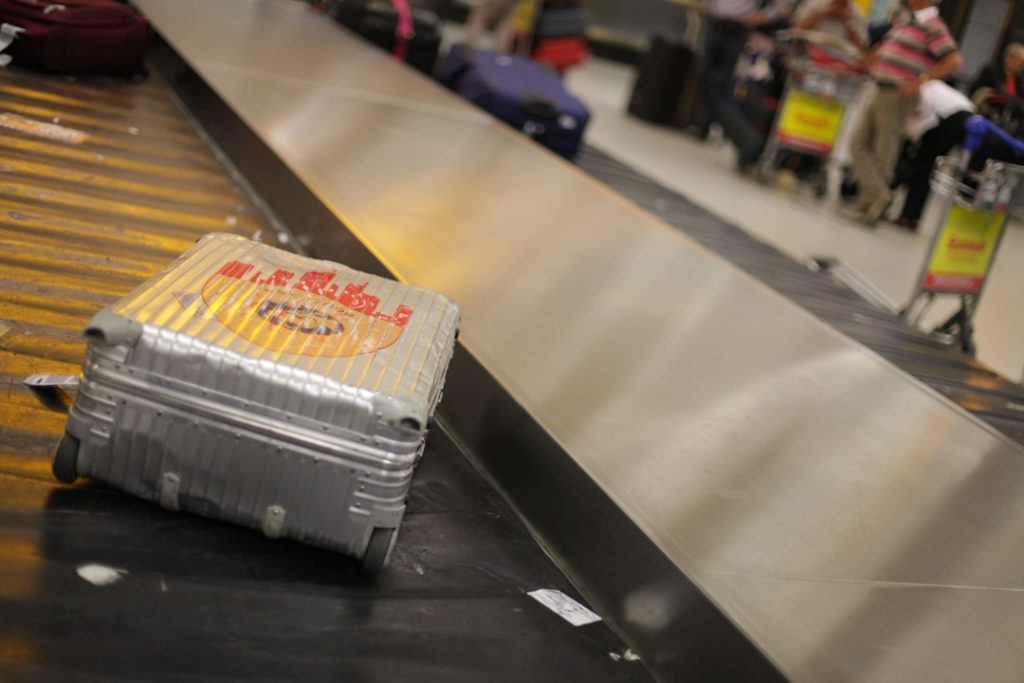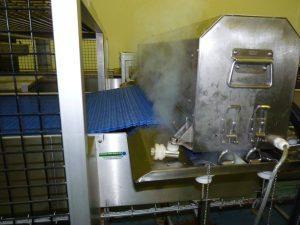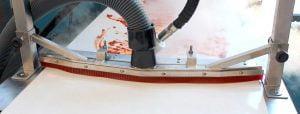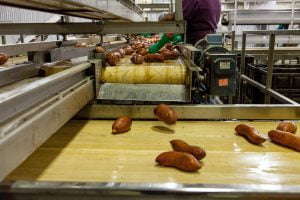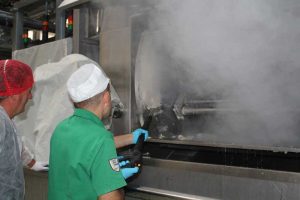Maximising ROI is crucial for any business, as it directly impacts profitability and long-term sustainability. In the food manufacturing industry, where margins can be tight and competition is fierce, it becomes even more critical to find ways to improve efficiency and reduce costs. By maximising ROI, food manufacturers can increase their profitability, reinvest in their operations, and stay ahead of the competition.
Conveyor belt cleaners play a significant role in maximising ROI in food manufacturing. Clean conveyor belts are essential for maintaining product quality and preventing contamination. When conveyor belts are not properly cleaned, they can become a breeding ground for bacteria and other pathogens, leading to product recalls, customer complaints, and potential legal issues. By investing in high-quality conveyor belt cleaners, food manufacturers can ensure that their products meet the highest standards of hygiene and safety, reducing the risk of contamination-related incidents.
The Benefits of Using Conveyor Belt Cleaners in Food Manufacturing
Using conveyor belt cleaners in food manufacturing offers several benefits that contribute to maximising ROI. Firstly, clean conveyor belts help improve operational efficiency. When belts are free from debris and contaminants, they can operate smoothly and without interruptions. This reduces downtime and increases productivity, allowing food manufacturers to produce more in less time.
Secondly, conveyor belt cleaners help extend the lifespan of the belts. When belts are not properly cleaned, debris and contaminants can accumulate, leading to premature wear and tear. This can result in costly repairs or even the need for replacement belts. By regularly cleaning the conveyor belts with effective cleaners, food manufacturers can prolong their lifespan, reducing maintenance costs and improving ROI.
Furthermore, clean conveyor belts contribute to better product quality. When belts are contaminated, there is a higher risk of cross-contamination between different food products. This can compromise the quality and safety of the products, leading to customer dissatisfaction and potential recalls. By investing in conveyor belt cleaners, food manufacturers can ensure that their products meet the highest standards of quality and safety, enhancing their reputation and customer satisfaction.
Types of Conveyor Belt Cleaners Available in the UK Market
In the UK market, there are several types of conveyor belt cleaners available for food manufacturers to choose from. The most common types include brush cleaners, scraper cleaners, and steam vapour cleaning machines.
Brush cleaners are designed to remove loose debris and particles from the conveyor belts. They consist of rotating brushes that sweep away dirt and contaminants as the belt moves. Brush cleaners are effective for light to moderate cleaning tasks but may not be suitable for heavy-duty applications or stubborn stains.
Scraper cleaners, on the other hand, use blades or scrapers to remove stubborn debris and contaminants from the conveyor belts. They are more effective than brush cleaners for heavy-duty cleaning tasks but may require more maintenance and adjustment to ensure optimal performance.
Steam vapour cleaning machines offer a unique approach to conveyor belt cleaning. These machines use high-temperature steam vapour to dissolve dirt and contaminants on the belts. The steam penetrates deep into the surface, killing bacteria and sanitising the belts. Steam vapour cleaning machines are highly effective for removing grease, oil, and other stubborn stains, making them ideal for food manufacturing environments where hygiene is of utmost importance.
The Role of Steam Vapour Cleaning Machines in Conveyor Belt Cleaning
| Type of Conveyor Belt Cleaner | Description | Advantages | Disadvantages |
|---|---|---|---|
| Primary Belt Cleaners | Installed on the head pulley and designed to remove the bulk of carryback material from the belt. | Effective at removing large amounts of material, reducing maintenance costs and increasing belt life. | May require frequent adjustment and can be difficult to install on some conveyor systems. |
| Secondary Belt Cleaners | Installed after the primary cleaner and designed to remove any remaining carryback material. | Improves cleaning efficiency and reduces the risk of material build-up on the return rollers. | May require more frequent maintenance and can be more expensive than primary cleaners. |
| Tertiary Belt Cleaners | Installed at the end of the conveyor and designed to remove any remaining carryback material. | Ensures maximum cleaning efficiency and reduces the risk of material build-up on the return rollers. | Can be more expensive than primary and secondary cleaners and may require more frequent maintenance. |
| V-Plough Belt Cleaners | Installed on the return side of the belt and designed to remove material from the belt edge. | Effective at removing material from the belt edge and reducing the risk of material build-up on the return rollers. | May not be suitable for all conveyor systems and can be more expensive than other types of cleaners. |
| Brush Belt Cleaners | Installed on the return side of the belt and designed to remove fine material from the belt surface. | Effective at removing fine material and reducing the risk of material build-up on the return rollers. | May not be suitable for all conveyor systems and can be more expensive than other types of cleaners. |
Steam vapour cleaning machines have gained popularity in recent years due to their effectiveness in conveyor belt cleaning. These machines use high-temperature steam vapour to dissolve dirt, grease, and contaminants on the belts. The steam penetrates deep into the surface, killing bacteria and sanitising the belts.
One of the key benefits of using steam vapour cleaning machines is that they do not require the use of chemicals or detergents. This makes them an environmentally friendly option for conveyor belt cleaning. The high-temperature steam alone is sufficient to remove most types of dirt and contaminants, reducing the need for additional cleaning agents.
Steam vapour cleaning machines also offer a faster and more efficient cleaning process compared to traditional methods. The high-temperature steam quickly dissolves dirt and contaminants, making it easier to remove them from the belts. This reduces the time required for cleaning and increases productivity in food manufacturing operations.
Furthermore, steam vapour cleaning machines provide a thorough and deep clean. The steam penetrates deep into the surface of the belts, reaching areas that may be difficult to access with other cleaning methods. This ensures that all dirt, grease, and bacteria are effectively removed, leaving the belts clean and sanitised.
How Automatic Conveyor Belt Steam Vacuums Can Improve ROI
Automatic conveyor belt steam vacuums are a type of steam vapour cleaning machine that can further improve ROI in food manufacturing. These machines combine the power of high-temperature steam with vacuum suction to provide a comprehensive cleaning solution for conveyor belts.
The use of automatic conveyor belt steam vacuums offers several benefits that contribute to maximising ROI. Firstly, these machines provide a faster and more efficient cleaning process compared to manual methods. The combination of high-temperature steam and vacuum suction allows for quick and thorough cleaning, reducing the time required for cleaning tasks and increasing productivity.
Secondly, automatic conveyor belt steam vacuums offer a more hygienic cleaning solution. The vacuum suction removes dirt, debris, and contaminants from the belts, preventing them from being spread around the food manufacturing environment. This reduces the risk of cross-contamination and helps maintain a clean and sanitary workspace.
Furthermore, automatic conveyor belt steam vacuums are easy to use and require minimal training. The machines are designed to be user-friendly, allowing operators to quickly and effectively clean the conveyor belts without the need for extensive training or expertise. This reduces the time and resources required for training, further improving ROI.
Factors to Consider When Choosing a Conveyor Belt Cleaner

When choosing a conveyor belt cleaner for food manufacturing, there are several factors that should be considered to ensure optimal performance and ROI. These factors include the type of conveyor belt, the level of cleaning required, the size of the operation, and the budget available.
The type of conveyor belt is an important consideration when choosing a cleaner. Different types of belts may require different cleaning methods or cleaners. For example, belts with a rough surface may require scraper cleaners to effectively remove debris and contaminants. On the other hand, belts with a smooth surface may be suitable for brush cleaners or steam vapour cleaning machines.
The level of cleaning required is another factor to consider. Some food manufacturing operations may require light cleaning on a regular basis, while others may require heavy-duty cleaning to remove stubborn stains or contaminants. It is important to choose a conveyor belt cleaner that is suitable for the specific cleaning needs of the operation.
The size of the operation is also an important consideration when choosing a conveyor belt cleaner. Larger operations may require more powerful or automated cleaners to handle the volume of cleaning required. Smaller operations, on the other hand, may be able to use manual or less powerful cleaners.
Finally, the budget available is a key factor to consider. Conveyor belt cleaners can vary in price depending on their features and capabilities. It is important to choose a cleaner that fits within the budget while still meeting the cleaning requirements of the operation.
Best Practices for Conveyor Belt Cleaning in Food Manufacturing
To maximise ROI and ensure optimal performance, it is important to follow best practices for conveyor belt cleaning in food manufacturing. These best practices include regular cleaning and maintenance, proper training for operators, and using the appropriate cleaning methods and equipment.
Regular cleaning and maintenance are essential for keeping conveyor belts clean and sanitary. It is recommended to establish a regular cleaning schedule and stick to it. This will help prevent the build-up of dirt and contaminants on the belts, reducing the risk of cross-contamination and ensuring product safety.
Proper training for operators is also crucial for effective conveyor belt cleaning. Operators should be trained on how to use the cleaning equipment correctly and safely. They should also be educated on the importance of maintaining clean conveyor belts and following proper hygiene practices.
Using the appropriate cleaning methods and equipment is another best practice for conveyor belt cleaning. As discussed earlier, different types of belts may require different cleaning methods or cleaners. It is important to choose the right equipment that is suitable for the specific needs of the operation.
Case Studies: Successful ROI Maximisation with Conveyor Belt Cleaners
Several case studies demonstrate successful ROI maximisation through the use of conveyor belt cleaners in food manufacturing. One such case study involves a large-scale bakery that implemented an automated conveyor belt steam vacuum system. The system allowed for faster and more efficient cleaning, reducing downtime and increasing productivity. As a result, the bakery was able to increase its production capacity by 20% while reducing maintenance costs by 15%.
Another case study involves a meat processing plant that invested in scraper cleaners for its conveyor belts. The scraper cleaners effectively removed stubborn debris and contaminants, reducing the risk of cross-contamination and improving product quality. As a result, the plant was able to reduce product recalls by 50% and increase customer satisfaction.
These case studies highlight the significant impact that conveyor belt cleaners can have on ROI in food manufacturing. By investing in the right cleaning equipment and following best practices, food manufacturers can achieve higher productivity, lower maintenance costs, and improved product quality, ultimately leading to increased profitability.
The Future of Conveyor Belt Cleaners in UK Food Manufacturing
In conclusion, conveyor belt cleaners play a crucial role in food manufacturing in the UK. They help maintain clean and sanitary conveyor belts, ensuring compliance with regulations and standards. Maximising ROI is essential for food manufacturers, and conveyor belt cleaners can contribute to achieving this goal.
By investing in high-quality conveyor belt cleaners, food manufacturers can improve operational efficiency, reduce downtime, extend the lifespan of belts, and enhance product quality. Steam vapour cleaning machines and automatic conveyor belt steam vacuums offer unique benefits that further improve ROI by providing faster and more efficient cleaning solutions.
When choosing a conveyor belt cleaner, it is important to consider factors such as the type of belt, the level of cleaning required, the size of the operation, and the budget available. Following best practices for conveyor belt cleaning, such as regular cleaning and maintenance, proper training for operators, and using appropriate cleaning methods and equipment, is also crucial for maximising ROI.
Case studies demonstrate successful ROI maximisation through the use of conveyor belt cleaners in food manufacturing. These case studies highlight the significant impact that these cleaners can have on productivity, maintenance costs, and product quality.
The future of conveyor belt cleaners in UK food manufacturing looks promising. As technology continues to advance, we can expect to see more innovative solutions that further improve efficiency and reduce costs. Food manufacturers are encouraged to consider implementing conveyor belt cleaners in their operations to maximise ROI and stay ahead of the competition.
FAQs
What is return on investment (ROI)?
Return on investment (ROI) is a financial metric used to measure the profitability of an investment. It is calculated by dividing the net profit of an investment by the cost of the investment.
What is conveyor belt cleaning equipment?
Conveyor belt cleaning equipment is a type of machinery used to clean conveyor belts in food manufacturing facilities. It is designed to remove debris, dirt, and other contaminants from the conveyor belt to ensure food safety and prevent contamination.
Why is ROI important for conveyor belt cleaning equipment in food manufacturing?
ROI is important for conveyor belt cleaning equipment in food manufacturing because it helps businesses determine the profitability of their investment. By calculating the ROI, businesses can determine whether the investment in conveyor belt cleaning equipment is worth the cost and whether it will provide a positive return on investment.
What factors affect the ROI of conveyor belt cleaning equipment in food manufacturing?
Several factors can affect the ROI of conveyor belt cleaning equipment in food manufacturing, including the cost of the equipment, the frequency of use, the cost of maintenance and repairs, and the impact on productivity and efficiency.
How can businesses improve the ROI of conveyor belt cleaning equipment in food manufacturing?
Businesses can improve the ROI of conveyor belt cleaning equipment in food manufacturing by ensuring that the equipment is used regularly and properly maintained. They can also invest in high-quality equipment that is designed to be durable and long-lasting, which can reduce the need for repairs and replacements.
What are the benefits of investing in conveyor belt cleaning equipment in food manufacturing?
Investing in conveyor belt cleaning equipment in food manufacturing can provide several benefits, including improved food safety, increased productivity and efficiency, reduced downtime and maintenance costs, and compliance with industry regulations and standards.


